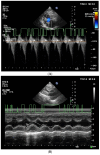Influence of Clinical Aspects and Genetic Factors on Feline HCM Severity and Development
- PMID: 38787186
- PMCID: PMC11125783
- DOI: 10.3390/vetsci11050214
Influence of Clinical Aspects and Genetic Factors on Feline HCM Severity and Development
Abstract
Hypertrophic cardiomyopathy (HCM), which is associated with thickening of the left ventricular wall, is one of the most common heart pathologies in cats. This disease has a hereditary etiology and is primarily related to mutations in the MYBPC3 and MYH7 genes. This study aims to determine the effect of the presence of heterozygosity or homozygosity for the p. A31P mutation (c.91G>C) in the MYBPC3 gene in cats (Maine Coon) of different ages referring to the HCM severity and development, and to compare echocardiographic data and various clinical aspects for the most objective detection of disease in cats of different breeds. The incidence of HCM was 59% of the 103 cases of heart disease in cats in this study. In 23 cats diagnosed with HCM, cats heterozygous for the mutation accounted for 34%, and homozygous cats accounted for 26%. Cats homozygous for this mutation had moderate to severe HCM, suggesting an association with high penetrance of HCM and a significant risk of cardiac death in this group. The penetrance of the heterozygous type was lower than that of the homozygous genotype. This study also indicates that HCM has some age-related penetrance. The disease did not occur in the study group of cats aged up to 1 year, whereas at the age of 7 and older, the percentage of animals diagnosed with HCM was the highest and amounted to 44.3% of the total number of studied cats with HCM.
Keywords: DNA testing; MYBPC3; cats; clinical diagnostics; hypertrophic cardiomyopathy (HCM); p. A31p mutation.
Conflict of interest statement
The authors declare no conflicts of interest.
Figures




Similar articles
-
Genotype-phenotype correlation between the cardiac myosin binding protein C mutation A31P and hypertrophic cardiomyopathy in a cohort of Maine Coon cats: a longitudinal study.J Vet Cardiol. 2015 Dec;17 Suppl 1:S268-81. doi: 10.1016/j.jvc.2015.10.005. J Vet Cardiol. 2015. PMID: 26776585
-
Precision medicine validation: identifying the MYBPC3 A31P variant with whole-genome sequencing in two Maine Coon cats with hypertrophic cardiomyopathy.J Feline Med Surg. 2019 Dec;21(12):1086-1093. doi: 10.1177/1098612X18816460. Epub 2018 Dec 18. J Feline Med Surg. 2019. PMID: 30558461 Free PMC article.
-
A Novel Homozygous Intronic Variant in TNNT2 Associates With Feline Cardiomyopathy.Front Physiol. 2020 Nov 16;11:608473. doi: 10.3389/fphys.2020.608473. eCollection 2020. Front Physiol. 2020. PMID: 33304277 Free PMC article.
-
Genetic Basis of Hypertrophic Cardiomyopathy in Cats.Curr Issues Mol Biol. 2024 Aug 12;46(8):8752-8766. doi: 10.3390/cimb46080517. Curr Issues Mol Biol. 2024. PMID: 39194734 Free PMC article. Review.
-
The genetic basis of hypertrophic cardiomyopathy in cats and humans.J Vet Cardiol. 2015 Dec;17 Suppl 1(Suppl 1):S53-73. doi: 10.1016/j.jvc.2015.03.001. J Vet Cardiol. 2015. PMID: 26776594 Free PMC article. Review.
Cited by
-
Life expectancy of cats in Britain: moggies and mollies live longer.PeerJ. 2025 Jan 30;13:e18869. doi: 10.7717/peerj.18869. eCollection 2025. PeerJ. 2025. PMID: 39897493 Free PMC article.
-
The Unseen Side of Feline Hypertrophic Cardiomyopathy: Diagnostic and Prognostic Utility of Electrocardiography and Holter Monitoring.Animals (Basel). 2024 Jul 25;14(15):2165. doi: 10.3390/ani14152165. Animals (Basel). 2024. PMID: 39123690 Free PMC article. Review.
References
-
- Gerull B., Klaassen S., Brodehl A. Genetic Causes of Cardiac Disease. Springer; Berlin/Heidelberg, Germany: 2019. The genetic landscape of cardiomyopathies; pp. 45–91. - DOI
-
- Ingles J., Goldstein J., Thaxton C., Caleshu C., Corty E.W., Crowley S.B., Dougherty K., Harrison S.M., McGlaughon J., Milko L.V., et al. Evaluating the Clinical Validity of Hypertrophic Cardiomyopathy Genes. Circ. Genom. Precis. Med. 2019;12:e002460. doi: 10.1161/circgen.119.002460. - DOI - PMC - PubMed
-
- Luis Fuentes V., Abbott J., Chetboul V., Côté E., Fox P.R., Häggström J., Kittleson M.D., Schober K., Stern J.A. ACVIM Consensus Statement Guidelines for the Classification, Diagnosis, and Management of Cardiomyopathies in Cats. J. Vet. Intern. Med. 2020;34:1062–1077. doi: 10.1111/jvim.15745. - DOI - PMC - PubMed
LinkOut - more resources
Full Text Sources
Miscellaneous

